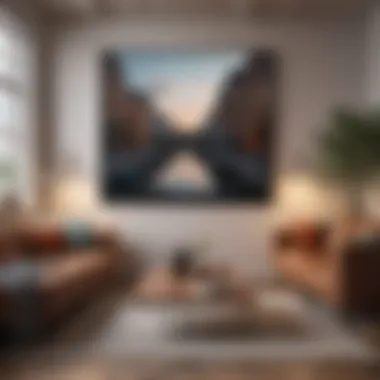The Best Way to Hang Photos on Your Wall


Intro
Hanging photos on walls is more than a simple task; it is an art form that transforms spaces. Photographs serve as visual narratives. They tell stories about people, places, and moments that matter. Therefore, the way in which these images are displayed has a significant effect on the overall aesthetic of a room. This article dives deep into methods, considerations, and techniques for hanging photos. Homeowners and design enthusiasts alike can benefit from the insights provided here, ensuring their walls are dynamic and pleasing.
Architectural Inspiration
Overview of Design Styles
When considering how to hang photos, it is important to recognize various design styles that influence placement and presentation. For example, in a minimalist setting, clean lines and lack of clutter guide the selection of photo size and frame. Meanwhile, a bohemian style might accommodate an eclectic mix of different frames and sizes, showing an array of colors and textures. Each design aesthetic shapes the approach to hanging photos.
Innovative Materials and Techniques
The choice of materials plays a crucial role in displaying photographs in a manner that complements the surrounding environment. Wood, metal, and acrylic frames each provide unique benefits. Wood frames can create a rustic feel, while metal frames lend a contemporary touch. Furthermore, specialized hanging techniques, like using shadow boxes for three-dimensional displays or clips for a casual look, can elevate photos from mere decorations to focal points in the room.
Interior Design Trends
Color Schemes and Their Psychological Effects
Colors influence emotions and perceptions. Selecting a color scheme that resonates with the photos displayed can significantly impact the ambience of a room. Neutral tones often provide a sophisticated backdrop, allowing vibrant images to draw the eye. Conversely, bold wall colors can enhance mood and provide drama, making the displayed photographs pop in contrast.
Space Optimization Tips
Maximizing wall space is essential in effective photo display. This can be achieved through thoughtful arrangements. Whether opting for gallery walls or simple linear alignments, consider the proportions of the room and the size of the photographs. Large images can be commanding in scale and work well in open spaces, while smaller images can be grouped together to create visual interest without overwhelming the surroundings.
"Thoughtful arrangement and selection can elevate any photograph from a simple image to an impactful display."
In summary, the way photographs are hung on walls is integral to personal expression and interior design. Architectural elements and the current trends in design both inform the manner in which photographs should be showcased. The process requires careful consideration of styles, materials, colors, and space. This guide provides a comprehensive understanding to enhance your living spaces meaningfully.
Understanding the Importance of Photo Display
Photo display is not just about aesthetics; it plays a crucial role in how we perceive our living spaces. Well-placed photographs can transform a room, making it feel more inviting and personalized. They serve as a reflection of our experiences, interests, and emotions. Understanding the importance of photo display allows one to appreciate how photographs can enhance the overall ambiance of a home.
One primary benefit of displaying photos is the emotional resonance they evoke. Each image captures a moment in time, often loaded with memories. Whether it's a family gathering, a travel adventure, or a special event, these moments remind us of what we value. Moreover, when guests see photographs on the walls, they gain insight into the homeowner's life, interests, and style, creating a deeper connection.
Moreover, thoughtfully arranged photos can create a visual narrative throughout a space. This allows for storytelling through imagery. A wall filled with pictures of travels not only showcases adventures but also motivates and inspires. This conceptual arrangement can be therapeutic and enriching. It connects our past with our present, making it a significant aspect of interior design.
Finally, practical considerations play a role in the importance of photo display. Choosing the right method for hanging photos not only impacts their aesthetics but also their longevity. Knowing how to properly secure photographs ensures they will remain intact and appreciated for years to come. This article will explore these aspects in detail, providing insights into the best approaches and practices for displaying photos.
Assessing Your Space
To achieve an appealing display of photographs, the first step involves assessing your space. Understanding the characteristics of your wall and the surroundings greatly influences the final arrangement. Poor placement can lead to a cluttered look, while thoughtful assessment can create harmony in your decor. This stage sets the foundation for all subsequent decisions about framing styles, layouts, and hanging techniques.
Measuring Available Wall Space
The process of measuring your available wall space is crucial. Use a tape measure to determine how much area you have to work with. Identify the width and height of the wall, considering any architectural features or obstacles like windows and doors. This information will help you visualize potential arrangements and prevent overcrowding of visual elements.
When measuring, consider these factors:
- Aspect ratio: Think about the proportions of the wall. A tall, narrow wall might benefit from vertical arrangements, while a wide wall could accommodate a broad layout.
- Visual weight: Balance the arrangement with larger photos counteracting smaller ones. Placing larger pieces on the bottom creates a solid base.
- Negative space: Allow gaps between the photos to avoid clutter. Negative space enhances the focus on each piece.
Considering Furniture Placement
The arrangement of furniture also holds significance when assessing your space. Photographs should complement the furniture rather than compete with it. If a sofa or large piece of furniture is in front of the wall, ensure the photos are hung at a height that draws attention without obstruction. You want the display to resonate within the room's overall aesthetic.
When analyzing furniture placement, take into account:


- Proximity: Place photos near corresponding furniture, like hanging a picture above a console table or a sofa.
- Flow of the room: Ensure the display does not disrupt the pathways people move through. It must be easily viewable without causing interference in everyday activities.
- Lighting conditions: Natural and artificial lighting should enhance the photographs. Make sure the wall space is well-lit to showcase the images effectively.
By closely examining these elements, you can create an organized and visually satisfying photograph display that enhances your space while showcasing your personal style.
Choosing the Right Photographs
Choosing the right photographs is crucial for creating a meaningful display in your home. Photos have the power to tell stories, evoke memories, and convey emotions. When selecting images, consider how they fit into the overall narrative you wish to present.
The selection process requires thoughtfulness and attention to detail. You should think about the themes or experiences you want to showcase. A well-chosen photograph can enhance the mood of a room, providing a glimpse into your life or interests. Some benefits of carefully selected photographs include:
- Personal Connection: Choosing images that resonate with you or represent significant moments brings warmth to your space.
- Aesthetic Appeal: Images that complement your decor can elevate the overall visual harmony in your home.
- Conversation Starters: Unique or breathtaking photos can engage visitors, prompting discussions about their stories and significance.
By understanding the importance of your photographic choices, you can create a display that is not just visually appealing but also emotionally resonant.
Selecting a Cohesive Theme
A cohesive theme binds your photographs together, creating a unified look. When selecting a theme, think about what message or feeling you want to convey. Popular themes include travel, family, nature, or a combination of personal experiences.
When selecting photographs within your chosen theme, consider:
- Color Palette: Does the color scheme of your photos complement each other? A consistent palette enhances visual unity.
- Style: Are your photos framed similarly or share a common aesthetic? This does not mean they all must be the same style, but there should be some relation.
- Subject Matter: Choose images that capture similar subjects or themes. This alignment fosters a stronger connection among the photographs.
With a clear theme in mind, you establish an effective visual narrative that enhances the overall impact of your photo display.
Mixing Sizes and Formats
Mixing sizes and formats adds depth to your photo arrangement. Variation can make the display more dynamic and engaging. Here are some considerations:
- Layering: Combine larger pieces with smaller ones to create layers. This approach draws the eye and offers visual interest.
- Grid vs. Asymmetrical Layout: A grid layout provides structure, while an asymmetrical layout offers a more creative, informal feel.
- Frame Choices: Different frame sizes and formats can complement various wall spaces. Consider how they contrast or align with each other.
Employing this mix will not only enhance the aesthetic appeal of your photos but also allow for personal expression in your arrangement.
"Every photograph can become a part of a larger story, where each piece interacts with the others to create a cohesive visual experience."
In summary, the selection of photographs goes beyond mere aesthetics. It involves thoughtful consideration of theme, size, and representation, ensuring that each piece contributes meaningfully to your display.
The Art of Frame Selection
Selecting the right frame for your photographs is a crucial step in the overall presentation of your display. Frames not only enhance the visual appeal of photos but also protect them from damage. Choosing the proper frame can elevate ordinary photographs into striking pieces of decor. The frame serves as a bridge between the image and its surroundings, anchoring it within the space and complementing the overall aesthetic of the room.
When considering frames, think about the style, material, and color. Each element plays a significant role in how the photos are perceived. A well-chosen frame can highlight the colors in your picture or provide a sharp contrast that makes the image stand out. Therefore, understanding the various options available for framing is essential.
Material Options for Frames
Frames come in various materials, each offering unique characteristics. Common materials include wood, metal, and plastic.
- Wood: Wooden frames provide a traditional look. They can be painted or stained, allowing flexibility in matching decor. Different types of wood can also contribute to a unique aesthetic, such as the warmth of oak compared to the sleekness of maple.
- Metal: Metal frames often give a modern and industrial feel. They are usually more durable and can support larger photographs without warp. These frames typically come in finishes like matte, glossy, or brushed, which can further enhance their look.
- Plastic: Plastic frames are a cost-effective option. They may not have the same aesthetic value but can be lightweight and available in many colors. They are also less likely to break compared to glass frames, making them suitable for more casual settings.
Ultimately, the choice of material should align with the intended style of the space and the significance of the photographs being framed.
Choosing Colors and Finishes
The color and finish of a frame are vital to its integration within your decor. Frames can either blend into the background or stand out as a focal point. Considering the colors present in the photograph is essential when choosing a frame.
- Neutrals: White, black, or gray frames can provide a classic touch. They can enhance any image without overwhelming it. Neutral frames work particularly well in contemporary settings as they often allow the artwork to take precedence.
- Bold Colors: Vibrant frames can bring life to a display. A red or blue frame can complement specific colors within the photograph, creating a harmonized look. This approach works effectively in informal spaces, such as children's rooms or casual living areas.
- Finish Options: Finishes can greatly affect the perceived quality of a frame. Glossy finishes reflect light and can create an eye-catching effect. Matte finishes, on the other hand, often provide a subdued elegance that feels sophisticated and timeless.
The right combination of frame material and color can transform a simple photography display into a well thought out art installation.


Frame selection is not merely about protecting pictures; it is about creating an appealing presentation that adds value to your home. When carefully considered, the frame becomes a vital part of the artistic expression of your photographs.
Hanging Techniques
Hanging techniques play a crucial role in the overall success of a photo display. These methods not only determine how securely your photographs are adhered to the wall but also influence the visual aesthetics of the arrangement. When selecting a technique, consider the wall material, the weight of the frames, and the desired layout. Successfully executed hanging techniques can provide a polished look and ensure that your photos remain intact for years.
Using Picture Hooks
Picture hooks are one of the most reliable methods for hanging photographs. They offer a strong hold, which is essential for heavier frames. To use picture hooks, first, ensure that you select a hook rated for the weight of your photo. Once you have the correct hook, measure where you want the top of the frame to hang, and then mark the wall. Fix the hook at the marked point using a hammer. Each frame will require its own hook, which helps to keep the arrangement secure.
Nailing vs. Adhesive Strips
Many people consider the choice between nailing and using adhesive strips, with each method bearing its own set of advantages. Nailing is ideal for stability, particularly with heavier pictures. It provides a solid anchor on various wall types. However, it may leave holes which could be undesirable in rental spaces. On the other hand, adhesive strips offer a damage-free solution and can be easily removed without leaving marks. They are suitable for lighter frames or temporary displays.
- Pros of Nailing:
- Cons of Nailing:
- Pros of Adhesive Strips:
- Cons of Adhesive Strips:
- Greater stability for heavier frames
- Secure anchoring on different wall types
- Potential for wall damage
- May necessitate repairs upon removal
- No wall damage
- Easy to reposition if needed
- Not suitable for heavier frames
- Limited durability over time
Employing a Gallery Wall Approach
A gallery wall approach can drastically enhance the visual appeal of a room. This technique allows for a more dynamic display of photos and artwork. When employing this method, choose a variety of frame sizes and styles to add interest. It is important to lay out the arrangement on the floor first as this will give you a clear visual guide and prevent unnecessary holes in the wall. After finalizing the layout, measure the space between frames to ensure consistency. A gallery wall can serve as a strong focal point in a room, making it perfect for living rooms or hallways.
The arrangement of a gallery wall should represent personal style and contribute to the overall integrity of the space.
To sum it up, hanging techniques are fundamental to the successful display of your photographs. Picture hooks, nailing versus adhesive strips, and a thorough consideration of gallery walls can help ensure an effective and aesthetically pleasing photo arrangement. Understanding these concepts allows you to create a display that not only showcases your photographs but also enhances the ambiance of your space.
Positioning Your Photos
Positioning your photographs correctly is a critical step in achieving an aesthetically pleasing and coherent display. Effective positioning not only showcases your photos but also enhances the overall ambiance of a room. When considering the arrangement of your wall art, various elements come into play. These include eye-level placement, balance, and symmetry. Each of these factors contributes significantly to how photographs interact with the surrounding space and how viewers engage with them.
Eye-Level Considerations
When hanging photos, eye level is one of the key factors to ensure optimal viewing. The general guideline suggests positioning photographs at an average eye level of about 57 to 60 inches from the floor. This height allows most viewers to appreciate the pieces without straining their necks.
Different factors may influence this ideal height:
- Room Purpose: In a living area, the eye level might need to accommodate seating arrangements, making it a bit lower. In contrast, art in a hallway or gallery may focus on standard heights.
- Audience: If children or guests are the primary viewers, reducing the height may allow for a more child-friendly display.
Positioning at eye level helps prevent the display from feeling haphazard and ensures a harmonious flow in the viewing experience. It invites interaction, making guests feel welcomed to engage with the images rather than merely glance at them.
Creating Balance and Symmetry
Balancing the arrangement and achieving symmetry adds visual interest and cohesion to your photo display. Consider these factors when creating balance:
- Visual Weight: Larger frames or darker colors tend to carry more visual weight. Arranging them strategically can create a balanced look against smaller, lighter frames.
- Spacing: Consistent spacing between each photograph aids in achieving a more organized appearance. Uneven spacing can lead to a cluttered feeling, detracting from the beauty of the photographs.
- Groupings: Creating clusters of photos can enhance a wall's design. For example, grouping three images of similar size in a triangle can create a visually pleasing focal point.
"Symmetry is not merely a design choice; it's a statement that commands attention and invites contemplation."
A symmetrical display creates a sense of order. However, asymmetry can convey dynamism if done right. It all depends on your vision for the space. The key is to ensure that the viewer's eye flows naturally across the arrangement, enjoying it as a unified whole rather than a collection of individual images.


Adjusting Based on Wall Type
Selecting the right method for hanging photographs is not just about aesthetics. One crucial aspect that informs the best practices in photo display is the type of wall surface you are working with. Different wall materials can affect not only the stability of your arrangement but also the style and visual impact of the design. Understanding these differences is essential for achieving a successful display.
Hanging on Drywall
Drywall, commonly found in most homes, offers various advantages when it comes to hanging photos. It is relatively easy to work with, and there are many tools and hardware options available. A simple picture hook or nail can often suffice for lightweight frames.
However, care must be taken when selecting hooks to ensure they are adequate for the weight of the frames you are using. For heavier photographs, using wall anchors or screws can help prevent shifting or falling. The general rule is to place the hook or screw into a stud for maximum support. To find a stud, a stud finder can be a useful tool, or you can gently knock on the wall to listen for solid sounds that indicate a stud's presence. This careful approach will help maintain the integrity of your photo display over time.
"Proper hanging methods can prolong the life of your photos and ensure they remain securely displayed."
Considerations for Brick or Concrete
Hanging photos on brick or concrete walls presents unique challenges that differ significantly from drywall. These surfaces are sturdy yet require specialized tools and techniques for effective display. Wall anchors designed for masonry, or tapcon screws, are often necessary.
Before starting, it is essential to pre-drill holes using a carbide-tipped masonry drill bit. This preparation allows for the installation of anchors that expand within the wall, providing a secure fit. Alternatively, adhesive strips designed for heavy-weight use can sometimes work on these surfaces if the photo frames are not exceptionally heavy.
When planning your layout, consider the texture and color of the brick or concrete. These factors will influence the overall appearance of your display. It might also be prudent to use a level to align your photos accurately, ensuring they are straight and visually appealing.
By adapting your hanging techniques according to wall type, you can achieve a sophisticated and enduring photo display that enhances your living space.
Maintaining and Updating Displays
Properly maintaining and updating photo displays is essential for keeping a living space feeling fresh and reflecting personal style. As seasons change or life events occur, updating your photos allows you to tell your current story. This practice not only rejuvenates the aesthetic appeal of your walls but also keeps the emotional connections alive. A dynamic arrangement can showcase recent memories while making room for new favorites.
Regularly Rotating Photos
Rotating photos is a simple yet effective way to keep your display engaging. This offers several benefits:
- Highlighting New Experiences: By replacing older photos with recent ones, you can showcase your latest travels or family milestones.
- Avoiding Familiarity: A changing display prevents any sense of monotony. It reminds viewers of past moments but keeps the focus relevant.
- Encouraging Reflection: Regularly re-evaluating what photos are shown can prompt you to reconsider the stories behind them.
When rotating your photos, consider establishing a timeline. Decide if you want to swap images monthly, quarterly, or seasonally. Make it a personal ritual to reassess your collection of photographs. This can lead to a more meaningful display over time. Each new arrangement can reflect who you are at that moment.
Cleaning and Caring for Frames
Cleaning and caring for frames is another important aspect of maintaining your photo display. Dust and grime can accumulate, diminishing the charm of your photographs. Here are some straightforward steps for effective cleaning:
- Remove Photos from Frames: Gently take the photos out before cleaning the frames. This prevents any unwanted marks or scratches.
- Use a Soft Cloth: A microfiber cloth is ideal for wiping down frames. Avoid harsh chemicals that might damage the materials.
- Check for Damage: While cleaning, inspect for any signs of wear. Loose corners or scratches may need repairs or replacement.
- Reframe Wisely: After cleaning, carefully reinsert the photos and securely fasten them.
Regular cleaning not only enhances the visual aspect of your display but also extends the life of your frames. Practicing proper care allows the beauty of your displayed memories to shine through. This attention to detail ensures that your photo displays remain vibrant and inviting.
Maintaining and updating your photo displays enriches your home environment, keeping personal narratives alive and visually appealing.
Finale
In the exploration of effective photo hanging methods, the conclusion serves as a pivotal juncture. It synthesizes the accumulated insights, reinforcing the significance of thoughtful arrangement. The way photographs are displayed directly influences the atmosphere of any space, becoming a testament to personal style and emotional narratives.
This article has discussed various aspects of hanging photos, from understanding one's space to exploring different hanging techniques. Key elements include evaluating wall type, selecting cohesive themes, and employing various frame styles. Each consideration enhances the visual impact, ensuring a curated presentation rather than mere decoration.
Final Thoughts on Photo Arrangement
A well-executed photo arrangement does not only beautify a wall; it contributes to the overall harmony of a room. When selecting photos and frames, aim for a balance between personal significance and aesthetic appeal. Think about what feelings you wish to evoke when entering a room.
Remember to:
- Select a cohesive theme that resonates with you.
- Vary the sizes and formats to create a dynamic visual experience.
- Consider the arrangement at eye level for maximum impact.
- Regularly update your photos to reflect changes in your life or preferences.
Opt for different frame materials and finishes to add depth and contrast in your display. Take the time to clean and maintain the frames to prolong their beauty. It is essential that the presentation remains fresh and engaging over time.
"The arrangement of photographs can create a dialogue between memories and the present, making every glance a reflection of who you are."
Ultimately, thoughtful photo arrangement can transform your wall into a compelling narrative muscle that speaks volumes about your experiences and tastes.







